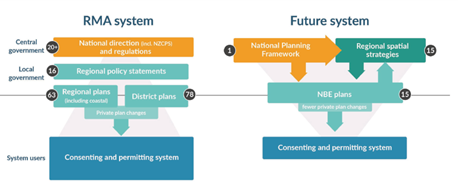NBEB and SPB - submissions for the summer holidays
Topics covered in this article: RMA & Local Government
Partners
Phone: +64 7 927 0590
Email: mhill@clmlaw.co.nz
Bachelor of Arts, Bachelor of Laws (First Class Honours), University of Canterbury
Master of Commercial Law (First Class Honours), University of Auckland
Special Counsel
Phone: +64 7 927 0522
Email: rzame@clmlaw.co.nz
Bachelor of Laws, Bachelor of Science, University of Otago
Senior Associate
Phone: +64 7 927 0595
Email: KStubbing@clmlaw.co.nz
LLB / BCom, University of Otago
The Natural and Built Environment Bill (NBEB) and Spatial Planning Bill (SPB) had their first reading in parliament on Tuesday 22 November 2022, and have progressed to the Environment Select Committee stage. Submissions on the bills close on 30 January 2023. This means people will have to grapple with the bills over the Christmas period – a busy time of year to be contemplating the significant changes to the resource management system the bills propose.
As foreshadowed by the findings of the Randerson report, the bills outline a significantly different system of resource management from that currently occurring under the RMA.
Most notable is the new plan setting and administration process proposed. Regional Planning Committees, consisting of representatives from local government and tangata whenua, will develop a single resource management plan per region. A Regional Spatial Strategy (RSS) will be developed first, setting high level long term direction on areas appropriate for development and protection, and infrastructure requirements. The preparation of the RSS is the primary focus of the SPB.
The RSS will then feed into the preparation of Natural and Built Environment Plans (NBEPs) prepared under the NBE Act, containing specific rules and regulations similar to current city, district and regional plans. NBEPs will also have to give effect to a new National Planning Framework (NPF), which will standardise commonly used definitions (e.g. ‘general residential zone’ and ‘sign’) and certain rules and regulations which will apply across the country (such as those currently found in National Policy Statements and National Environmental Standards).
The new system is geared towards resolving issues at the front end, through the RSS and NBEP setting process, and reducing the need for and complexity of resource consents. The proposed new framework involves more permitted activities (which don’t need consent), less restrictive activity categories (removing “non-complying” activities), and less resource consent appeal rights. Existing local authorities will retain the consenting and compliance functions under the NBEPs.
The below diagram demonstrates the reduction in planning documents and processes under the new system:
Other key features of the new system and some early observations from the Environment Committee through the first reading include:
Outcomes and limits vs effects – the NBEB focusses on achieving environmental outcomes rather than the former focus on environmental effects. Desired “outcomes” include climate change mitigation, well-functioning urban and rural areas, and environmental protection and restoration. This is to be achieved through the setting of environmental limits for natural environments such as air, coastal waters, and soils. The bill does not currently provide a hierarchy among outcomes, to enable the exercise of discretion by decision-makers, which may lead to challenges as to ‘what outcome rules’.
Treaty of Waitangi principles elevated in decision making – under the RMA, decision makers were required to ‘take into account’ the principles of the Treaty of Waitangi; a relatively low test requiring the decision maker to simply turn their mind to the principles when considering a proposal. Decision makers will now have to ‘give effect to’ the principles, with guidance to be developed by MfE as to what shifts in practice will be required. Demonstration of this in the decision making process will be important to avoid or successfully defend anticipated litigation.
Significant improvements in enforcement provisions – The NBEB proposes a raft of changes to enforcement provisions, including increases to financial penalties (up to $10 million for corporates), the introduction of cost recovery mechanisms for regulators for enforcement and prosecution, and the ability to consider compliance history when assessing applications for resource consents. The bill also proposes to make insurance against fines unlawful, which is expected to better incentivise corporates to have good policies around environmental compliance.
No more ‘first in – first served’ – Under the RMA, resources were effectively allocated through the ‘first in-first served’ rule, particularly relating to water. For example, if a waterbody has limited water available for taking under the relevant plan (usually linked to protection of ecological values), water would be allocated through the consenting process to whoever lodged their application first, receiving priority over those who came later, often resulting in conflict. Under the NBEB, allocation decisions will be made in accordance with the principles of sustainability, equity, and efficiency. Allocation methods are to be developed through the NPF or NBEPs, with freshwater to be the first resource considered through a new Freshwater Working Group.
Section 32 reports to be slimmed down – under the NBEB, evaluation reports for proposed plans or changes must be ‘expressed succinctly and plainly’ and ‘contain a level of detail that is proportionate to the scale and significance of the proposal’. Minister Parker has described section 32 reports provided under the RMA as “hopelessly long-winded, post-fact justifications and are hardly used”.
Farewell to ‘Amenity’ – the RMA definition of environment includes amenity, and amenity values are relevant considerations under the RMA. This concept has been deliberately removed from the NBEB – perhaps unsurprising given amenity was often the subject of “NIMBY” related challenges to consents issued under the RMA and became a poster child for RMA reform. Environment Committee member Rachel Brooking considers the removal of the concept of amenity from the new legislation is one of the fundamental and important changes proposed under the reforms.
Tree rules are back… sort of - Under the National Planning Framework, councils will be directed to develop an urban forest strategy including percentage targets for canopy cover, to be included in the regional NBEP’s. Associate Environment Minister Phil Twyford signalled that, given the 10 year timeframe expected for these rules to take effect, the Government would make amendments to the RMA and possibly provide national direction as a transition measure to achieve urban forest goals. Tree scheduling will remain, but this is not intended as a return to the controversial blanket tree protection rules of pre-2009.
Next steps
The changes are significant and will affect a wide range of interests and businesses. The late January deadline for submissions on such a significant reform is already generating criticism from a variety of interests. The Minister has expressed a desire to have the legislation passed before the 2023 election.
Our specialist Resource Management Team has been following the reform since the Randerson Report was released, and are well placed to help you understand the changes and what they will mean for your business. If you would like assistance drafting your submission or have questions about the proposed reform, please get in touch with a member of our Resource Management team.








